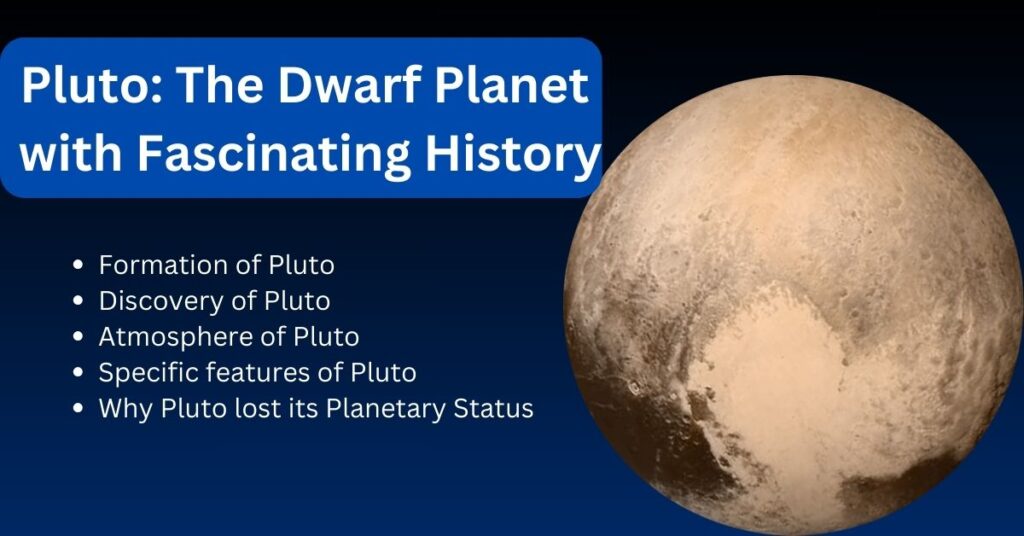

For decades, astronomers and space enthusiasts have been fascinated with Pluto, previously thought to be the eighth planet in our solar system. Pluto, despite being reclassified as a dwarf planet, continues to pique people’s curiosity owing to its unique traits, fascinating atmosphere, and long history. This blog delves into Pluto’s discovery, origin, atmosphere, distinctive traits, the reasons for its planetary status shift, and a final reflection on its significance in our cosmic neighborhood.
Discovery of Pluto
Clyde Tombaugh, an American astronomer, discovered Pluto on February 18, 1930, at Flagstaff, Arizona’s Lowell Observatory. Percival Lowell launched the hunt for Pluto, predicting the possibility of a ninth planet beyond Neptune owing to orbital discrepancies between Uranus and Neptune. After years of monitoring, Tombaugh discovered Pluto, a tiny and distant celestial planet at the fringe of the solar system.
Formation of Pluto
Pluto is thought to have originated around 4.6 billion years ago, during the early phases of the solar system. Scientists believe Pluto formed in the Kuiper Belt, a region beyond Neptune teeming with frozen comets, asteroids, and dwarf planets. Pluto’s creation was most likely caused by the accretion of rock and ice when smaller celestial bodies coalesced over time. Its composition, largely rock and ice, distinguishes it from the gas giants and terrestrial planets.
Pluto’s Atmosphere
Pluto has a thin and volatile atmosphere mostly made up of nitrogen (N₂), methane (CH₄), and carbon monoxide. The atmospheric pressure is incredibly low, approximately 100,000 times lower than Earth’s atmosphere. Pluto’s ices sublimate as it approaches closer to the Sun in its eccentric orbit, creating a gaseous atmosphere. As Pluto moves away from the Sun, the gasses condense back into ice, resulting in dramatic seasonal fluctuations.
Specific Features
Surface Composition: – Pluto’s surface is composed of nitrogen, methane, and carbon monoxide ice, giving it a shiny and somewhat reddish look.
Tombaugh Regio: – One of Pluto’s most prominent features is the enormous, heart-shaped Tombaugh Regio, which is made up of Sputnik Planitia, a gigantic nitrogen-ice plain.
Mountains and Valley: – Pluto has water-ice mountains, some towering over 3,500 meters (11,000 feet) high, suggesting geologic activity.
Glaciers and Canyons: – Pluto has active glaciers and long canyons, indicating past and present geological activity.
Pluto’s Moons: – Pluto has five known moons—Charon, Styx, Nix, Kerberos, and Hydra—with Charon being the largest, about half the size of Pluto itself.
Why Pluto Lost Its Planetary Status
In 2006, the International Astronomical Union (IAU) redefined the criteria for what constitutes a planet. According to the new definition, a celestial body must:
- Orbit the Sun.
- Have sufficient mass to assume a nearly round shape.
- Clear its orbit of other debris.
While Pluto fits the first two characteristics, it does not clean its orbit of additional debris since it is in the Kuiper Belt, which contains several similar-sized objects. As a result, Pluto was reclassified as a dwarf planet in 2006, sparking heated debate and controversy among astronomers and the public.
Conclusion
Pluto is no longer officially acknowledged as a planet, yet it remains an important topic of research in planetary science. The New Horizons mission, which returned the first close-up photographs of Pluto in 2015, revealed the planet’s complex surface, dynamic atmosphere, and continuous geological activity. Pluto continues to test our understanding of planetary creation and evolution, demonstrating that even a dwarf planet may have a big influence on our understanding of the solar system. Pluto, whether designated as a planet or a dwarf planet, will always have a unique place in the minds of both space fans and scientists.
